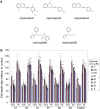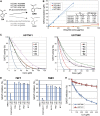Novel plant immune-priming compounds identified via high-throughput chemical screening target salicylic acid glucosyltransferases in Arabidopsis
- PMID: 22960909
- PMCID: PMC3480303
- DOI: 10.1105/tpc.112.098343
Novel plant immune-priming compounds identified via high-throughput chemical screening target salicylic acid glucosyltransferases in Arabidopsis
Abstract
Plant activators are compounds, such as analogs of the defense hormone salicylic acid (SA), that protect plants from pathogens by activating the plant immune system. Although some plant activators have been widely used in agriculture, the molecular mechanisms of immune induction are largely unknown. Using a newly established high-throughput screening procedure that screens for compounds that specifically potentiate pathogen-activated cell death in Arabidopsis thaliana cultured suspension cells, we identified five compounds that prime the immune response. These compounds enhanced disease resistance against pathogenic Pseudomonas bacteria in Arabidopsis plants. Pretreatments increased the accumulation of endogenous SA, but reduced its metabolite, SA-O-β-d-glucoside. Inducing compounds inhibited two SA glucosyltransferases (SAGTs) in vitro. Double knockout plants that lack both SAGTs consistently exhibited enhanced disease resistance. Our results demonstrate that manipulation of the active free SA pool via SA-inactivating enzymes can be a useful strategy for fortifying plant disease resistance and may identify useful crop protectants.
Figures





Similar articles
-
Imprimatins A and B: novel plant activators targeting salicylic acid metabolism in Arabidopsis thaliana.Plant Signal Behav. 2012 Dec;7(12):1715-7. doi: 10.4161/psb.22368. Epub 2012 Oct 16. Plant Signal Behav. 2012. PMID: 23073003 Free PMC article.
-
Isolation and characterization of the plant immune-priming compounds Imprimatin B3 and -B4, potentiators of disease resistance in Arabidopsis thaliana.Plant Signal Behav. 2012 Dec;7(12):1526-8. doi: 10.4161/psb.22138. Epub 2012 Oct 16. Plant Signal Behav. 2012. PMID: 23073018 Free PMC article.
-
The expression patterns of AtBSMT1 and AtSAGT1 encoding a salicylic acid (SA) methyltransferase and a SA glucosyltransferase, respectively, in Arabidopsis plants with altered defense responses.Mol Cells. 2009 Aug 31;28(2):105-9. doi: 10.1007/s10059-009-0108-x. Epub 2009 Jul 30. Mol Cells. 2009. PMID: 19669626
-
NPR1 in JazzSet with Pathogen Effectors.Trends Plant Sci. 2018 Jun;23(6):469-472. doi: 10.1016/j.tplants.2018.04.007. Epub 2018 May 9. Trends Plant Sci. 2018. PMID: 29753632 Review.
-
The Past, Present, and Future of Plant Activators Targeting the Salicylic Acid Signaling Pathway.Genes (Basel). 2024 Sep 23;15(9):1237. doi: 10.3390/genes15091237. Genes (Basel). 2024. PMID: 39336828 Free PMC article. Review.
Cited by
-
The glycosyltransferase UGT76B1 modulates N-hydroxy-pipecolic acid homeostasis and plant immunity.Plant Cell. 2021 May 5;33(3):735-749. doi: 10.1093/plcell/koaa045. Plant Cell. 2021. PMID: 33955489 Free PMC article.
-
Loliolide, a Carotenoid Metabolite, Is a Potential Endogenous Inducer of Herbivore Resistance.Plant Physiol. 2019 Apr;179(4):1822-1833. doi: 10.1104/pp.18.00837. Epub 2019 Jan 30. Plant Physiol. 2019. PMID: 30700538 Free PMC article.
-
Modulation of Plant Salicylic Acid-Associated Immune Responses via Glycosylation of Dihydroxybenzoic Acids.Plant Physiol. 2018 Apr;176(4):3103-3119. doi: 10.1104/pp.17.01530. Epub 2018 Feb 26. Plant Physiol. 2018. PMID: 29483147 Free PMC article.
-
Thienopyrimidine-type compounds protect Arabidopsis plants against the hemibiotrophic fungal pathogen Colletotrichum higginsianum and bacterial pathogen Pseudomonas syringae pv. maculicola.Plant Signal Behav. 2017 Mar 4;12(3):e1293222. doi: 10.1080/15592324.2017.1293222. Plant Signal Behav. 2017. PMID: 28277972 Free PMC article.
-
Sulforaphane Modifies Histone H3, Unpacks Chromatin, and Primes Defense.Plant Physiol. 2018 Mar;176(3):2395-2405. doi: 10.1104/pp.17.00124. Epub 2017 Dec 29. Plant Physiol. 2018. PMID: 29288231 Free PMC article.
References
-
- Dangl J.L., Jones J.D. (2001). Plant pathogens and integrated defence responses to infection. Nature 411: 826–833 - PubMed
-
- Dean J.V., Mohammed L.A., Fitzpatrick T. (2005). The formation, vacuolar localization, and tonoplast transport of salicylic acid glucose conjugates in tobacco cell suspension cultures. Planta 221: 287–296 - PubMed
Publication types
MeSH terms
Substances
LinkOut - more resources
Full Text Sources
Other Literature Sources
Research Materials

